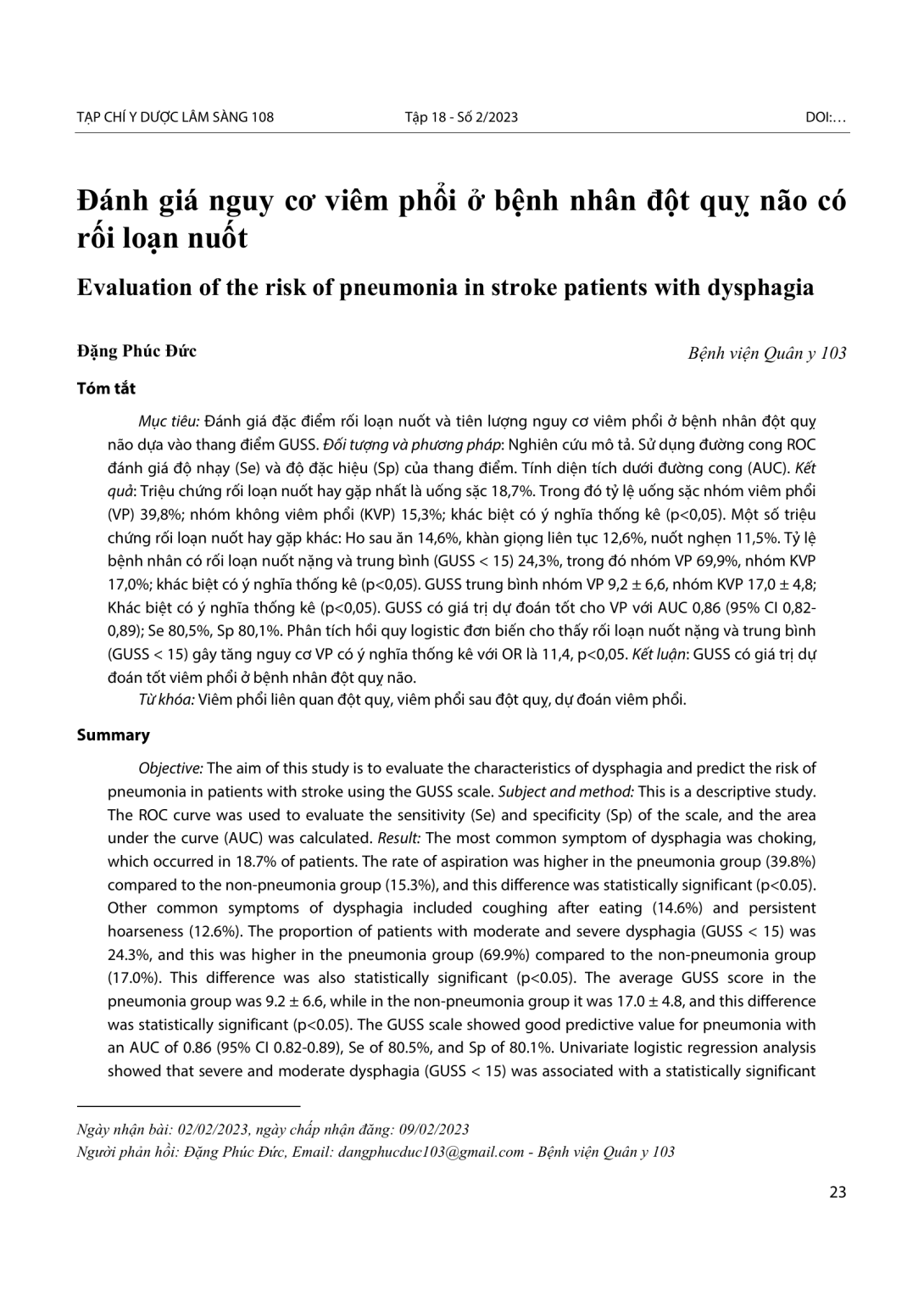
Đánh giá đặc điểm rối loạn nuốt và tiên lượng nguy cơ viêm phổi ở bệnh nhân đột quỵ não dựa vào thang điểm GUSS. Đối tượng và phương pháp: Nghiên cứu mô tả. Sử dụng đường cong ROC đánh giá độ nhạy (Se) và độ đặc hiệu (Sp) của thang điểm. Tính diện tích dưới đường cong (AUC). Kết quả: Triệu chứng rối loạn nuốt hay gặp nhất là uống sặc 18,7%. Trong đó tỷ lệ uống sặc nhóm viêm phổi (VP) 39,8%; nhóm không viêm phổi (KVP) 15,3%; khác biệt có ý nghĩa thống kê (p<0,05). Một số triệu chứng rối loạn nuốt hay gặp khác: Ho sau ăn 14,6%, khàn giọng liên tục 12,6%, nuốt nghẹn 11,5%. Tỷ lệ bệnh nhân có rối loạn nuốt nặng và trung bình (GUSS < 15) 24,3%, trong đó nhóm VP 69,9%, nhóm KVP 17,0%; khác biệt có ý nghĩa thống kê (p<0,05). GUSS trung bình nhóm VP 9,2 ± 6,6, nhóm KVP 17,0 ± 4,8; Khác biệt có ý nghĩa thống kê (p<0,05). GUSS có giá trị dự đoán tốt cho VP với AUC 0,86 (95% CI 0,82- 0,89); Se 80,5%, Sp 80,1%. Phân tích hồi quy logistic đơn biến cho thấy rối loạn nuốt nặng và trung bình (GUSS < 15) gây tăng nguy cơ VP có ý nghĩa thống kê với OR là 11,4, p<0,05. Kết luận: GUSS có giá trị dự đoán tốt viêm phổi ở bệnh nhân đột quỵ não.
The aim of this study is to evaluate the characteristics of dysphagia and predict the risk of pneumonia in patients with stroke using the GUSS scale. Subject and method: This is a descriptive study. The ROC curve was used to evaluate the sensitivity (Se) and specificity (Sp) of the scale, and the area under the curve (AUC) was calculated. Result: The most common symptom of dysphagia was choking, which occurred in 18.7% of patients. The rate of aspiration was higher in the pneumonia group (39.8%) compared to the non-pneumonia group (15.3%), and this difference was statistically significant (p<0.05). Other common symptoms of dysphagia included coughing after eating (14.6%) and persistent hoarseness (12.6%). The proportion of patients with moderate and severe dysphagia (GUSS < 15) was 24.3%, and this was higher in the pneumonia group (69.9%) compared to the non-pneumonia group (17.0%). This difference was also statistically significant (p<0.05). The average GUSS score in the pneumonia group was 9.2 ± 6.6, while in the non-pneumonia group it was 17.0 ± 4.8, and this difference was statistically significant (p<0.05). The GUSS scale showed good predictive value for pneumonia with an AUC of 0.86 (95% CI 0.82-0.89), Se of 80.5%, and Sp of 80.1%. Univariate logistic regression analysis showed that severe and moderate dysphagia (GUSS < 15) was associated with a statistically significant increase in the risk of pneumonia with an OR of 11.4, p<0.05. Conclusion: The results of this study show that the GUSS scale has good predictive value for pneumonia in patients with stroke.
- Đăng nhập để gửi ý kiến
